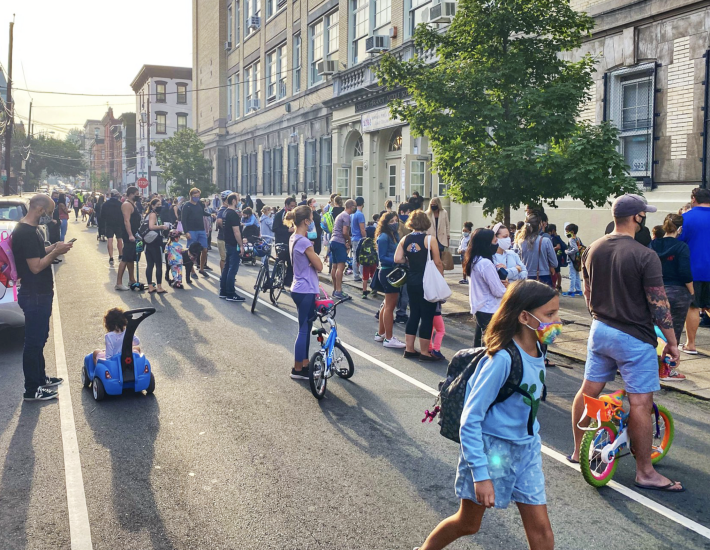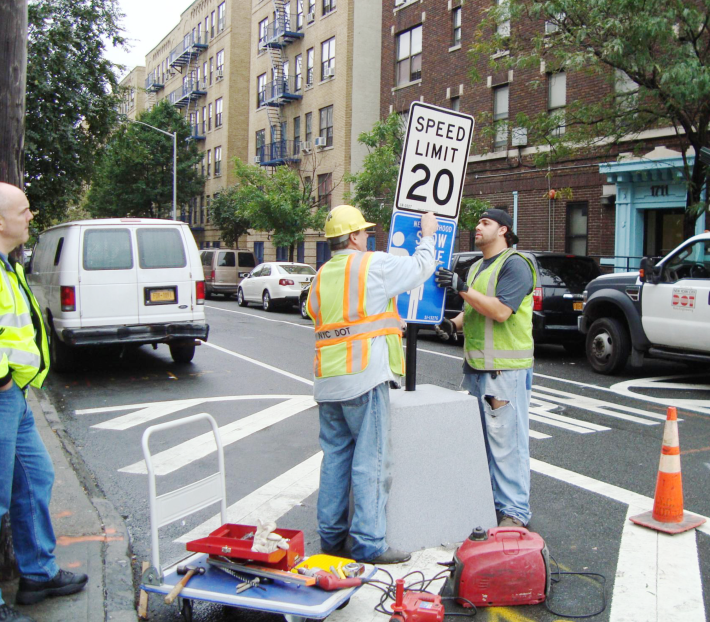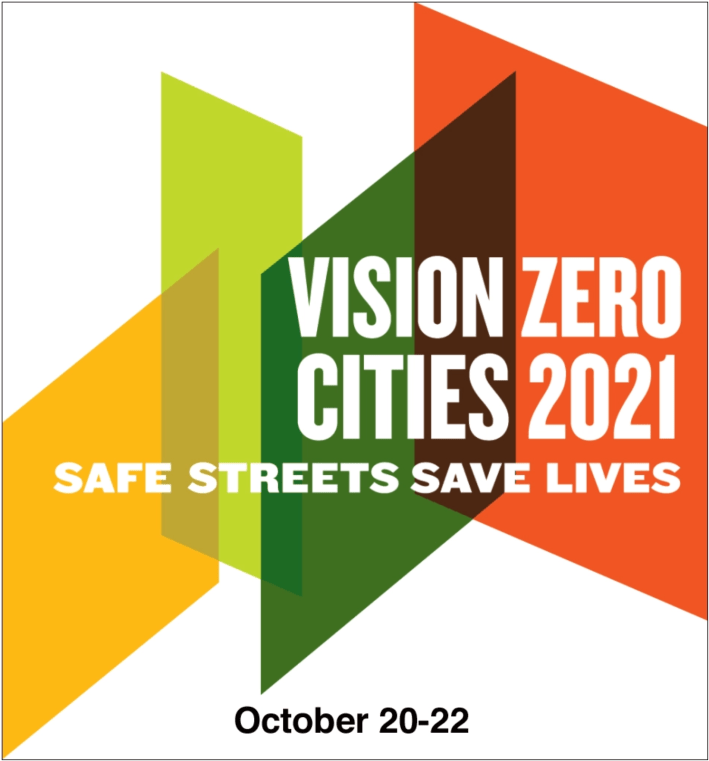Editor’s Note: A version of this article will appear in Transportation Alternatives’s Vision Zero Cities Journal as part of the 2021 Vision Zero Cities Conference, Oct. 20-22, including walking and biking tours on Oct. 22. You can register for the virtual conference (and for New York City residents, in-person tours) at visionzerocities.org.
The United States stands out among peer nations as the most dangerous place to walk, bike, and drive. We lose nearly 40,000 people each year to traffic violence, a per-capita rate double that of the European Union and Canada. Pedestrian deaths, concentrated in our pedestrian-dense cities, have been rising steeply for a decade and reached a 30-year high in 2019. And a recent study found that 75 percent of our country’s most dangerous roads for pedestrians border low-income neighborhoods, clear evidence that the U.S. traffic-safety crisis is not borne evenly by all communities.
In 2020, with lockdowns halting commutes across the country and a 13 percent overall decline in traffic volumes from the previous year, even more people died on U.S. roads. The National Highway Traffic Safety Administration estimates that deaths from crashes rose by eight percent, representing a 24 percent increase from 2019 when normalized for vehicle miles traveled.
These trends point to an unavoidable truth: We have built our roads to encourage deadly driving speeds, and traffic congestion is one of the only “tools” keeping our rising fatality rate from being even worse than it is. Last year showed us that when drivers have space to travel as fast as they want, more people will die. But while all this is dire news, the past year also saw cities around the country utilizing both time-tested and brand-new solutions to change their unsafe streets.
In response to pandemic-related shutdowns, many cities put their safety engineering toolboxes on hyper-drive. Prior to the pandemic, temporary redesigns across the country had already proven their safety-worth on streets, such as Las Olas Boulevard in Fort Lauderdale, King Street in Alexandria, or Corbett Porch in Tucson. Using lessons learned from quick-build projects like these, in 2020, some communities leveraged rapid response street closures to advocate for long-needed traffic safety upgrades.

In Durham, N.C., community-rooted partner SpiritHouse collaborated with city staff to engage residents of East Durham about what makes a shared street feel safe and inclusive to them. A longstanding fixture in the neighborhood, SpiritHouse crafted a thoughtful, multi-stage engagement process to gather input from community members about their experience using their streets. The process revealed that for those in East Durham, longstanding traffic safety concerns were a higher priority than basic Shared Streets installations. Together, the City, community members, local artists, and SpiritHouse ultimately created Shared Streets with little more than paint on the ground, incorporating safety improvements like traffic circles, chicanes, and corner bulb-outs to slow traffic, with space for residents to walk and bike.
A COVID response program in Oakland similarly uncovered important street safety needs. There, the DOT implemented 21 miles of Slow Streets between April and July 2020. While some people rejoiced, others shined a light on the city’s inequitable approach to making rapid changes to the street without talking or listening to community members. In response, Oakland DOT conducted an evaluation of the program, emphasizing outreach to East Oaklanders and people of color who were suffering disproportionate harm from the pandemic. In these conversations, residents expressed ongoing concerns about traffic safety and speeding, and revealed distrust in the Slow Streets traffic-calming measures and a desire for the city to focus on more pressing COVID-19 issues. In May, Oakland DOT pivoted their program, adding an “Essential Places” tool to their toolbox, and deploying temporary traffic safety improvements on dangerous arterials to improve access to essential services in East Oakland. The evolution of these rapid response programs in both Durham and Oakland reveals that cities must continue to assess and revise their toolboxes to address their ongoing traffic safety crisis, even in the midst of a more visible national emergency.

Informed speed-management policy — including speed limit setting — is the foundation for safe street design. That is why in 2020, NACTO published City Limits, the first-ever guidance on how to set speed limits on city streets by placing safety as the top transportation priority. Building off best practice in places like Seattle and New York, the guidance recommends that cities toss the dangerous approach of setting speed limits based on how fast drivers are already traveling, and instead use a street’s conflict density and activity level — who’s using the street and who cities want to be using the street — to determine the safest maximum speed. And even in 2020, a year of tight budgets, several U.S. cities put this guidance into practice to lower the speed limits on their streets.

One notable example was in NACTO member city Atlanta. There, following the formation of a new DOT with a significantly more multimodal focus than the previous Department of Public Works, the City Council approved an ordinance to reduce the default citywide speed limit to 25 mph on most city streets in April 2020. The changes went into effect one year later, and on at least one high-priority street, Marietta Boulevard, the City will be applying NACTO’s recommended methodology to bring speed limits down over time.
NACTO member Austin also prioritized speed limit reductions during 2020. In June, the City Council approved an ordinance to reduce speed limits to 25 mph on most residential streets and streets in the downtown core. These changes were the result of a comprehensive traffic and engineering study that evaluated, among other factors, where crashes were happening on the street network. With their new 25 mph speed limits, Austin and Atlanta join a growing list of major cities that have done the same.
While these efforts are a leap forward for local streets, in the U.S., where structural racism is embedded into all aspects of society, efforts to tame speeds and reduce traffic fatalities will fail without thoughtful consideration of how to enforce traffic laws and regulate speeds on those streets. With the country’s most fundamental inequities laid bare by the pandemic and 2020’s racial reckoning, a small vanguard of U.S. cities are taking first steps to rethink traffic enforcement. Their aim is simple: Ensure that the goal of safe streets applies to everyone, and all types of safety — from traffic safety to safety from police harm.
In July 2020, Berkeley’s City Council approved a proposal recommending the formation of a new transportation agency, BerkDOT, which would take responsibility for unarmed parking and traffic enforcement. And in February of this year, they unanimously passed a series of police reformsthat include focusing traffic enforcement resources on safety, eliminating stops for low-level offenses, and requiring written consent for all searches. Meanwhile, in neighboring Oakland, the City Council voted to form a Reimagining Public Safety Taskforce in July of 2020, charged with developing recommendations to increase community safety while reducing the Police Department’s General Purpose Fund budget by 50 percent. Their final report, published in May 2021, recommends removing the Oakland Police Department from traffic enforcement and reorganizing traffic enforcement under the Oakland Department of Transportation.
In Oakland, Berkeley, and beyond, cities are taking steps to reform their approach to policing, acknowledging the systemic racism that is baked into traffic-enforcement programs.
Other cities are exploring automated enforcement options, which have proven safety benefits, and can reduce the discretionary nature of manual traffic enforcement as well as the number of interactions between the police and the public, and save resources. New York City recently doubled down on its automated enforcement initiative, expanding its speed camera program to more than 2,000 cameras across the city’s 750 school zones. A report on the efficacy of the program shows that speeding at typical fixed camera locations dropped 72 percent in five years, and injuries dropped 17 percent. Importantly, because they are a predictable enforcement tool, speed cameras have been proven to actually deter speeding: New York’s data shows that two-thirds of the vehicles that receive one camera violation do not receive a second, and the average number of tickets issued by a school speed camera plummets by around two-thirds in the first 18 months.
Saving lives should be reason enough to redesign streets for safety. But it turns out that designing streets for lower speeds helps with a broad brush of challenges facing the U.S. today, from climate change, to equity, economic opportunity, and even the enjoyment of cities’ most abundant public spaces: their streets. A street environment that feels safe for everyone encourages people of all ages and abilities to leave their gas-guzzling cars behind, and make trips by foot, bike, and transit.
Safe-street conditions also improve access for users who travel long distances to school and work, and who may not own a single-occupancy vehicle to move from place to place. And the pandemic highlighted how safe streets are active streets, creating space for people to walk, roll, dine, and learn outdoors. City staff and community partners are doing the difficult work to make streets safer, and encouragingly sustained their momentum even during 2020. Their tireless efforts are saving lives, improving economies, reconnecting communities, and strengthening the very fabric that makes cities dynamic and vibrant places to live.
Jenny O’Connell is a Senior Program Manager at the National Association of City Transportation Officials.







